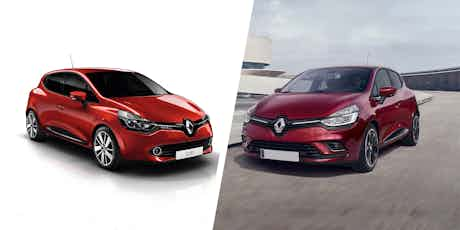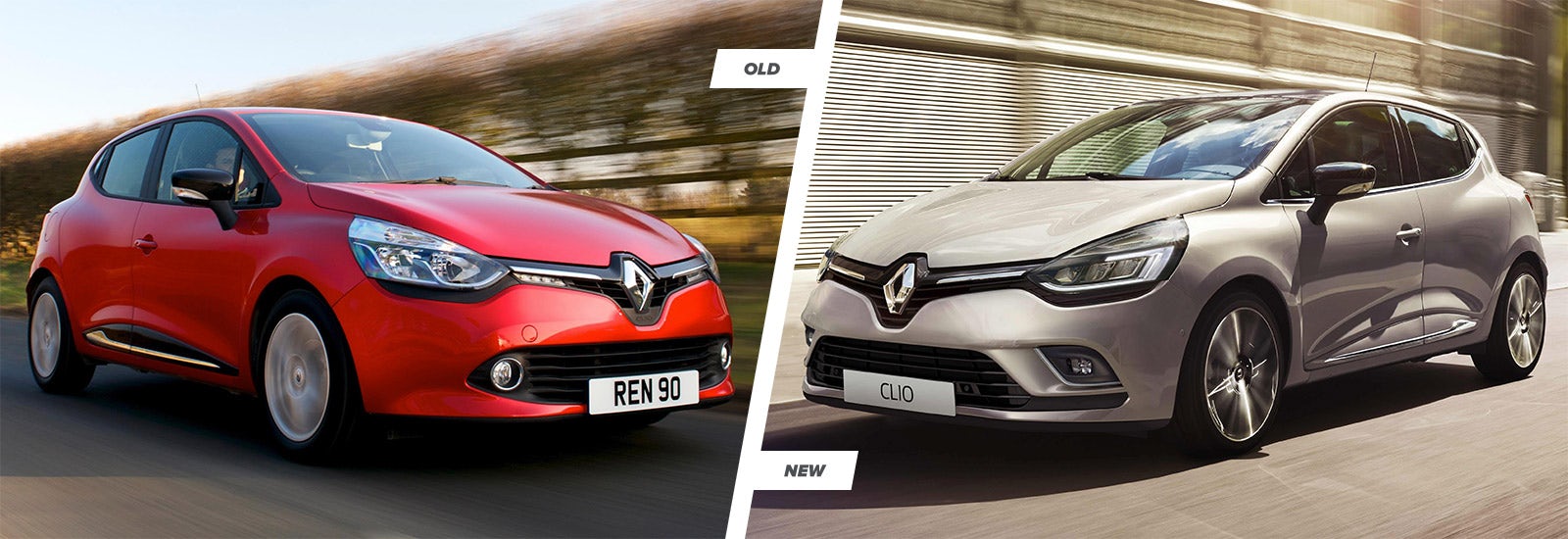Renault Clio facelift: old vs new compared
June 17, 2016 by carwow staff

The Renault Clio has now been around for 25 years and, to celebrate, Renault has given its most popular model a mid-life facelift. Here we compare it to the outgoing model to see what changes the French firm has made, and whether it’s worth waiting until October when the refreshed model is released.
If you don’t want to wait for the new model, use our Renault Clio deals page to find the best offers available. Alternatively, check out our list of best superminis for more great options.

Renault Clio old vs new – styling
The current Clio was a return to form in terms of styling – the supermini’s svelte lines and oversized headlights were a world away from its rather dull predecessor. Despite having gone on sale in 2012, it still looks fresh and details including the plastic and chrome inserts on the door have been carried across to other popular models, such as the Captur and new Megane.
Renault has sensibly decided not to mess with the Clio’s looks too much when it comes to the facelifted car. The subtle changes to the lower grille and integration of the LED running lights into the headlights give a slightly more grown-up appearance. Plus, when optioned with some of the new alloy wheel designs and updated colour palate, the Clio comes close to matching the chic appeal the original car had.

Renault Clio old vs new – interior
Climb inside the current Clio and you’ll discover an interior that’s a lot more interesting to look at than many of its major rivals. A touchscreen infotainment system comes as standard, and there are plenty of unusual touches such as the asymmetric ventilation controls and funky seat patterns. Perceived quality isn’t quite up there with the Volkswagen Polo, but it’s much more reasonably priced in base trims.
The facelifted model keeps this design, but offers upgraded materials including ones with a wood grain finish. There’s also additional equipment on offer – three grades of infotainment, all with smartphone integration, plus an optional Bose speaker system to really make a racket. Parking sensors are standard on all models, but buyers can now option a rear parking camera, too.
In terms of practicality, there have been no changes made, so the Clio can still seat four in relative comfort, with a fifth passenger being able to squeeze in the rear at a push. A 300-litre boot is reasonable for a car in this class and slightly beats or matches most rivals – those after more space should check out the Captur.

Renault Clio old vs new – driving and engines
As far as we know, Renault hasn’t made any changes to the way in which the Clio drives. That means it’s not quite as entertaining as the Ford Fiesta, but holds its own on challenging roads while still offering a comfortable ride on the motorway. Refinement is also impressive, and gives the Clio a big car feel that’s missing from some of its main rivals.
The outgoing car offers a grand total of four engines – excluding the hot RenaultSport Clio – but not all are available with both manual and automatic gearboxes. The basic option is a 75hp 1.2-litre petrol, but that’s best overlooked for the 89hp 0.9-litre turbocharged three-cylinder engine. A more powerful 120hp is also available, but only with an automatic gearbox. Diesel lovers can pick a 90hp 1.5-litre engine available in either automatic or manual versions, plus a green ‘ECO’ version.
The new car retains all of these engines but adds a couple of extra choices for discerning buyers. The 120hp petrol engine is now available with a manual gearbox, finally giving buyers a ‘warm’ hatch option if they want to change gear themselves. There’s also a new 110hp version of the 1.5-litre diesel engine, giving long distance drivers a good option to consider.

Renault Clio old vs new – value for money
All versions of the Clio should be relatively inexpensive to run – the most inefficient engine is also the least powerful, and should achieve 51.4mpg. Stepping up to the more turbocharged 90hp petrol engine increases this to 61.4mpg, and the most efficient diesel claims 88.3mpg. We don’t expect either of the new engines to be dramatically different in terms of running costs but Renault is yet to release the official figures.
The cheapest Clio you can buy will cost you £11,495 – a little more than the cheapest versions of rivals, but they usually come with less standard equipment. The most expensive car will set you back £17,725 and comes in racy looking GT-Line trim. We’d expect prices to rise slightly for facelifted cars, and the uprated diesel might end up costing buyers close to £19,000 for a top-spec model.

Renault Clio old vs new – verdict
The current Clio remains a stylish and capable supermini so, if you want a new car now and are keen to get the best value for money possible, it’ll be the best choice for you. However the facelifted model adds some undeniable extra appeal to the French supermini, so we can’t blame you if you’re tempted to wait a few months for the new car.

Save money on your new Renault Clio
Check out our Renault Clio deals page to see how much carwow could help you save on the current car. For more options, head over to our car chooser to narrow down your search or see our car deals page for our latest discounts.















